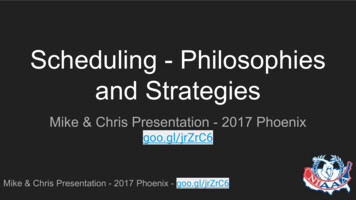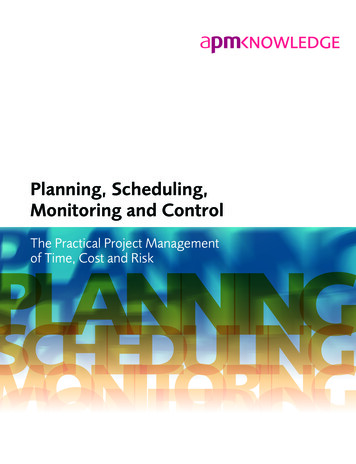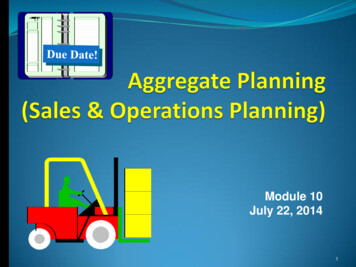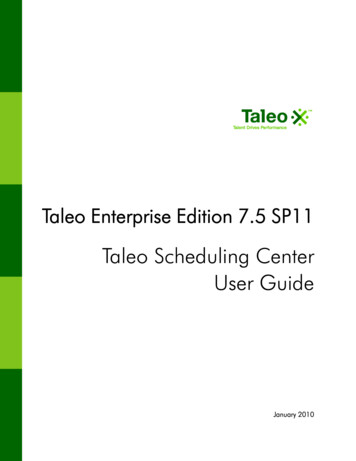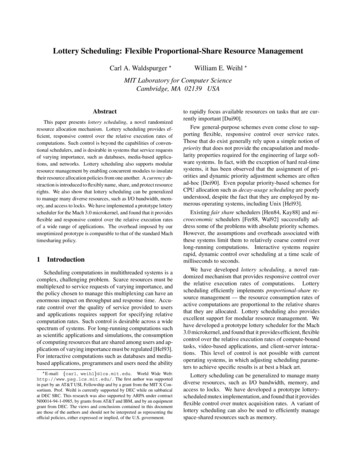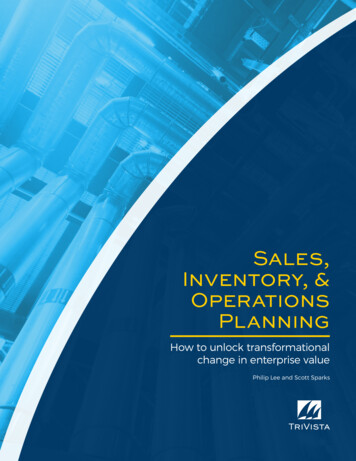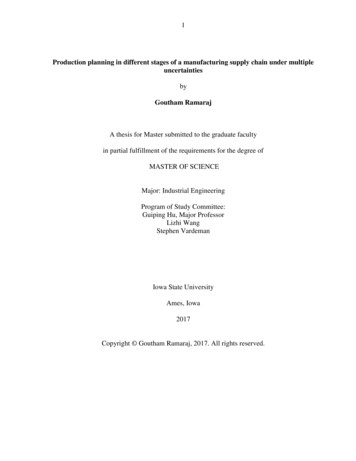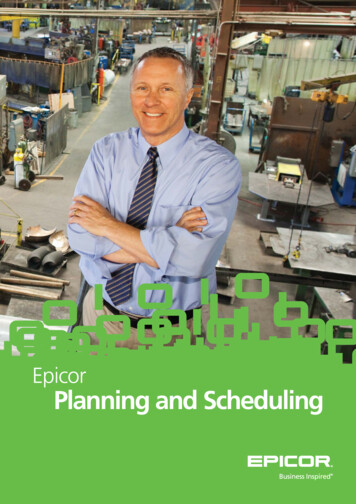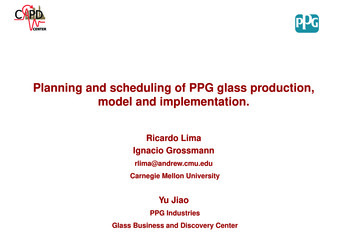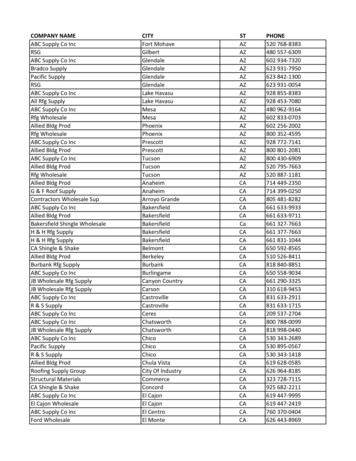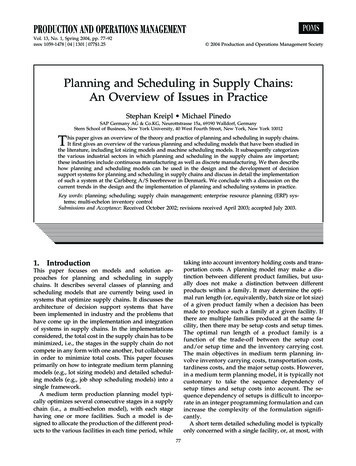
Transcription
POMSPRODUCTION AND OPERATIONS MANAGEMENTVol. 13, No. 1, Spring 2004, pp. 77–92issn 1059-1478 兩 04 兩 1301 兩 077 1.25 2004 Production and Operations Management SocietyPlanning and Scheduling in Supply Chains:An Overview of Issues in PracticeStephan Kreipl Michael PinedoSAP Germany AG & Co.KG, Neurottstrasse 15a, 69190 Walldorf, GermanyStern School of Business, New York University, 40 West Fourth Street, New York, New York 10012This paper gives an overview of the theory and practice of planning and scheduling in supply chains.It first gives an overview of the various planning and scheduling models that have been studied inthe literature, including lot sizing models and machine scheduling models. It subsequently categorizesthe various industrial sectors in which planning and scheduling in the supply chains are important;these industries include continuous manufacturing as well as discrete manufacturing. We then describehow planning and scheduling models can be used in the design and the development of decisionsupport systems for planning and scheduling in supply chains and discuss in detail the implementationof such a system at the Carlsberg A/S beerbrewer in Denmark. We conclude with a discussion on thecurrent trends in the design and the implementation of planning and scheduling systems in practice.Key words: planning; scheduling; supply chain management; enterprise resource planning (ERP) systems; multi-echelon inventory controlSubmissions and Acceptance: Received October 2002; revisions received April 2003; accepted July 2003.1.Introductiontaking into account inventory holding costs and transportation costs. A planning model may make a distinction between different product families, but usually does not make a distinction between differentproducts within a family. It may determine the optimal run length (or, equivalently, batch size or lot size)of a given product family when a decision has beenmade to produce such a family at a given facility. Ifthere are multiple families produced at the same facility, then there may be setup costs and setup times.The optimal run length of a product family is afunction of the trade-off between the setup costand/or setup time and the inventory carrying cost.The main objectives in medium term planning involve inventory carrying costs, transportation costs,tardiness costs, and the major setup costs. However,in a medium term planning model, it is typically notcustomary to take the sequence dependency ofsetup times and setup costs into account. The sequence dependency of setups is difficult to incorporate in an integer programming formulation and canincrease the complexity of the formulation significantly.A short term detailed scheduling model is typicallyonly concerned with a single facility, or, at most, withThis paper focuses on models and solution approaches for planning and scheduling in supplychains. It describes several classes of planning andscheduling models that are currently being used insystems that optimize supply chains. It discusses thearchitecture of decision support systems that havebeen implemented in industry and the problems thathave come up in the implementation and integrationof systems in supply chains. In the implementationsconsidered, the total cost in the supply chain has to beminimized, i.e., the stages in the supply chain do notcompete in any form with one another, but collaboratein order to minimize total costs. This paper focusesprimarily on how to integrate medium term planningmodels (e.g., lot sizing models) and detailed scheduling models (e.g., job shop scheduling models) into asingle framework.A medium term production planning model typically optimizes several consecutive stages in a supplychain (i.e., a multi-echelon model), with each stagehaving one or more facilities. Such a model is designed to allocate the production of the different products to the various facilities in each time period, while77
78Kreipl and Pinedo: Planning and Scheduling in Supply ChainsProduction and Operations Management 13(1), pp. 77–92, 2004 Production and Operations Management Societya single stage. Such a model usually takes more detailed information into account than a planningmodel. It is typically assumed that there are a givennumber of jobs and each one has its own parameters(including sequence-dependent setup times and sequence-dependent setup costs). The jobs have to bescheduled in such a way that one or more objectivesare minimized, e.g., the number of jobs that areshipped late, the total setup time, and so on.Clearly, planning models differ from schedulingmodels in a number of ways. First, planning modelsoften cover multiple stages and optimize over a mediumterm horizon, whereas scheduling models are usuallydesigned for a single stage (or facility) and optimize overa short term horizon. Second, planning models use moreaggregate information, whereas scheduling models usemore detailed information. Third, the objective to beminimized in a planning model is typically a total costobjective and the unit in which this is measured is amonetary unit; the objective to be minimized in a scheduling model is typically a function of the completiontimes of the jobs and the unit in which this is measuredis often a time unit. Nevertheless, even though there arefundamental differences between these two types ofmodels, they often have to be incorporated into a singleframework, share information, and interact extensivelywith one another.Planning and scheduling models may also interactwith other types of models, such as long term strategicmodels, facility location models, demand management models, and forecasting models; these modelsare not discussed in this paper. The interactions withthese other types of models tend to be less intensiveand less interactive. In what follows, we assume that thephysical settings in the supply chain have already beenestablished; the configuration of the chain is given, andthe number of facilities at each stage is known.Supply chains in the various industries are often notvery similar and may actually give rise to differentsets of issues and problems. This paper considers applications of planning and scheduling models in supply chains in various industry sectors. A distinction ismade between two types of industries, namely thecontinuous manufacturing industries (which includethe process industries) and the discrete manufacturingindustries (which include, for example, automotiveand consumer electronics). Each one of these two maincategories is subdivided into several subcategories.This categorization is used because of the fact that theplanning and scheduling procedures in the two maincategories tend to be different. We focus on the frameworks in which the planning and scheduling modelshave to be embedded; we describe the type of information that has to be transferred back and forth between the modules and the kinds of optimization thatis done within the modules.There is an extensive literature on supply chainmanagement. Many papers and books focus on supply chain coordination; a significant amount of thiswork has an emphasis on inventory control, pricingissues, and the value of information; see Simchi-Levi,Kaminsky, and Simchi-Levi (2000), Chopra andMeindl (2001), and Stadtler and Kilger (2000). There isalso an extensive literature on production planningand scheduling theory. A significant amount of research has been done on the solution methods applicable to planning and scheduling models; see Shapiro(2001). Planning models and scheduling models haveoften been studied independently from one another inorder to obtain elegant theoretical results. Planningmodels are often based on (multi-echelon) inventorytheory and lot sizing; see Zipkin (2000), Kimms (1997),Drexl and Kimms (1997), Muckstadt and Roundy(1993), and Dobson (1987, 1992). Scheduling modelstypically focus on how to schedule a number of jobs ina given machine environment in order to minimizesome objective. For general treatises on scheduling,see Bhaskaran and Pinedo (1992), Brucker (1998),Pinedo (2002), and Pinedo and Chao (1999). For applications of scheduling to supply chain management,see Hall and Potts (2000) and Lourenco (2001). Someresearch has been done on more integrated models inthe form of hierarchical planning systems; this research has resulted in frameworks that incorporateplanning and scheduling; see Bowersox and Closs(1996), Barbarosoglu and Ozgur (1999), DhaenensFlipo and Finke (2001), Shapiro (2001), and Miller(2002). For examples of descriptions of successful industrial implementations, see Haq (1991), Arntzen,Brown, Harrison, and Trafton (1995), Hadavi (1998),and Shepherd and Lapide (1998).This paper is organized as follows. The second sectiondescribes and categorizes some of the typical industrialsettings. The third section discusses the overall frameworks in which planning models as well as schedulingmodels have to be embedded. The fourth section describes a standard mixed integer programming formulation of a planning model for a supply chain. The fifthsection covers a typical formulation of a schedulingproblem in a facility in a supply chain. The sixth sectiondescribes an actual implementation of a planning andscheduling software system at the Danish beerbrewerCarlsberg A/S. The last section presents the conclusionsand discusses the impact of the Internet on decisionsupport systems in supply chains.2.Supply Chain Settings andConfigurationsThis section gives a concise overview of the varioustypes of supply chains. It describes the differences inthe characteristics and the parameters of the various
Kreipl and Pinedo: Planning and Scheduling in Supply ChainsProduction and Operations Management 13(1), pp. 77–92, 2004 Production and Operations Management Societycategories. It first describes the various different industry groups and their supply chain characteristicsand then discusses how the different planning andscheduling models analyzed in the literature can beused in the management of these chains. One canmake a distinction between two types of manufacturing industries, namely:(I) Continuous manufacturing industries (e.g., theprocess industries),(II) Discrete manufacturing industries (e.g., cars,semiconductors).These two industry sectors are not all-encompassing;the borderlines are somewhat blurry and may overlap.However, planning and scheduling in continuousmanufacturing (the process industries) often have todeal with issues that are quite different from those indiscrete manufacturing.Continuous Manufacturing. Continuous manufacturing (process) industries often have various types ofdifferent operations. The most common types of operations can be categorized as follows:(I-a) Main processing operations,(I-b) Finishing or converting operations.Main Processing Operations in Continuous Manufacturing (I-a). The main production facilities in the process industries are, for example, paper mills, steelmills, aluminum mills, chemical plants, and refineries.In paper, steel, and aluminum mills, the machines takein the raw material (e.g., wood, iron ore, alumina) andproduce rolls of paper, steel, or aluminum, whichafterwards are handled and transported with specialized material-handling equipment. Machines that dothe main processing operations typically have veryhigh startup and shutdown costs and usually workaround the clock. A machine in the process industriesalso incurs a high changeover cost when it has toswitch over from one product to another. Variousmethodologies can be used for analyzing and solvingthe models for such operations, including cyclicscheduling procedures and Mixed Integer Programming approaches.Finishing Operations in Continuous Manufacturing(I-b). Many process industries have some form of finishing operations that do some converting of the output of the main production facilities. This convertingusually involves cutting of the material, bending, folding, and possibly painting or printing. These operations often (but not always) produce commodity-typeitems, for which the producer has many clients. Forexample, a finishing operation in the paper industrymay produce cut size paper out of the rolls that comefrom the paper mill. The paper finishing business isoften a mixture of Make-To-Stock (mts) and Make-ToOrder (mto). If it operates according to mto, then thescheduling is based on customer due dates and sequence-dependent setup times. This leads often to79single machine and parallel machine scheduling models. If it operates according to mts, then it may followa so-called s-S or Q-R inventory control policy. If it isa mixture of mto and mts, then the scheduling policiesbecome a mixture of inventory control and detailedscheduling rules.Discrete Manufacturing. The discrete manufacturingindustry sector is quite diverse and includes the automotive industry, the appliances industry, and the pcindustry. From the perspective of planning and scheduling, a distinction can be made between three different types of operations in this sector. The reason formaking such a distinction is based on the fact thatplanning and scheduling in these three segments arequite different.(II-a) Primary converting operations (e.g., cuttingand shaping of sheet metal),(II-b) Main production operations (e.g., productionof engines, pcbs, wafers), and(II-c) Assembly operations (e.g., cars, pcs).Primary Converting Operations in Discrete Manufacturing (II-a). Primary converting operations are somewhat similar to the finishing operations in the processindustries. These operations may typically includestamping, cutting, or bending. The output of this operation is often a particular part that is cut and bentinto a given shape. There are usually few operationsdone on such an item, and the routing in such a facilityis relatively simple. The final product of a primaryconverting facility is usually not a finished good, butbasically a part or piece made of a single material(boxes, containers, frames, stamped body parts of cars,and so on). Examples of the types of operations in thiscategory are stamping plants that produce body partsfor cars, and plants that produce epoxy boards ofvarious sizes for the facilities that produce PrintedCircuit Boards. The planning and scheduling procedures under II-a may be similar to those under I-b.However, they may be here more integrated with theoperations downstream.Main Production Operations in Discrete Manufacturing(II-b). The main production operations are those operations that require multiple different operations bydifferent machine tools, and the product (as well as itsparts) may have to follow a certain route through thefacility going through various work centers. Capitalinvestments have to be made in various types of machine tools (lathes, mills, chip fabrication equipment).For example, in the semiconductor industry, waferstypically have to undergo hundreds of steps. Theseoperations include oxidation, deposition, and metallization, lithography, etching, ion implantation, photoresist stripping, and inspection and measurements.It is often the case that certain operations have to beperformed repeatedly and that certain orders have tovisit certain workcenters in the facility several times,
80Kreipl and Pinedo: Planning and Scheduling in Supply ChainsProduction and Operations Management 13(1), pp. 77–92, 2004 Production and Operations Management Societyi.e., they have to recirculate through the facility. Insemiconductor and Printed Circuit Board manufacturing, the operations are often organized in a job shopfashion. Each order has its own route through thesystem, its own quantity (and processing times), andits own committed shipping date. An order typicallyrepresents a batch of identical items that requires sequence-dependent setup times at many operations.Assembly Operations in Discrete Manufacturing (II-c).The main purpose of an assembly facility is to putdifferent parts together. An assembly facility typicallydoes not alter the shape or form of any one of theindividual parts (with the possible exception of thepainting of the parts). Assembly operations usually donot require major investments in machine tools, but dorequire investments in material handling systems (andpossibly robotic assembly equipment). An assemblyoperation may be organized in workcells, in assemblylines, or according to a mixture of workcells and assembly lines. For example, pcs are assembled in workcells, whereas cars and TVs are typically put togetherin assembly lines. Workcells typically do not requireany sequencing, but they may be subject to learningcurves. In assembly operations that are set up in a line,the sequencing is based on grouping and spacing heuristics combined with committed shipping dates. Theschedules that are generated by the grouping and spacing heuristics typically affect not only the throughput ofthe line, but also the quality of the items produced.Supply chains in both continuous and discrete manufacturing may have, besides the stages describedabove, additional stages. In a supply chain in a processindustry, there may be a stage preceding Stage I-a inwhich the raw material is being gathered at its point oforigination (which may be a forest or a mine) andtaken to the main processing operations. There mayalso be a distribution stage following stage I-b. Acompany may have its own distribution centers indifferent geographical locations, where it keeps certain SKUs in stock for immediate delivery. The company may also ship directly from its manufacturingoperations to customers. A supply chain in a discretemanufacturing industry also may have other types ofstages. There may be a stage preceding stage II-a inwhich raw material is being collected at a supplier(which may be an operation of the type I-b) andbrought to a primary converting operation. There mayalso be a stage following stage II-c which would consist of distribution operations (e.g., dealerships).Supply chains in both continuous and discrete manufacturing may have several facilities at each one ofthe stages, each one feeding into several facilities atstages downstream. The configuration of an entirechain may be quite complicated: For example, theremay be assembly operations that produce subassemblies that have to be fed into a production operation.Table 1Sector(I-a)(I-b)(II-a)(II-b)(II-c)ProcessesTime y lowmedium/lowvery lowmedium/lowhighThere are some basic differences between the parameters and operating characteristics of the facilitiesin the two main categories described above. Several ofthese differences have an impact on the planning andscheduling processes, including the differences in (i)the planning horizon, (ii) the clock-speed, and (iii) thelevel of product differentiation.(i) The planning horizon in continuous manufacturing facilities tends to be longer than the planninghorizon in the discrete manufacturing facilities. Incontinuous as well as in discrete manufacturing theplanning horizons tend to be shorter more downstream in the supply chain.(ii) The so-called “clock-speed” tends to be higherin a discrete manufacturing facility than in a continuous manufacturing facility. A high clock-speed implies that existing plans and schedules often have to bechanged or adjusted; that is, planning and schedulingis more reactive. In continuous as well as in discretemanufacturing, the clock-speed increases the moredownstream in the supply chain.(iii) In discrete manufacturing, there may be a significant amount of mass customization and productdifferentiation. In continuous manufacturing, masscustomization does not play a very important role.The number of SKUs in discrete manufacturing tendsto be significantly larger than the number of SKUs incontinuous manufacturing. The number of SKUstends to increase more downstream in the supplychain.These operating characteristics are summarized inTable 1. Because of these differences, the planning andscheduling issues in each one of the sectors can bevery different. Table 2 presents a summary of themodel types that can be used in the different categories as well as the corresponding solution techniques.Note that problems that have continuous variablesmay lead to Mixed Integer Programming (mip) formulations, whereas problems that have only discrete variables may lead to pure Integer Programming (ip)formulations (or Disjunctive Programming formulations). However, a discrete problem in which certainvariables assume large values (i.e., the number of unitsto be produced) may be replaced by a continuousproblem, resulting in a Mixed Integer Programmingformulation rather than a pure Integer Programming
Kreipl and Pinedo: Planning and Scheduling in Supply ChainsProduction and Operations Management 13(1), pp. 77–92, 2004 Production and Operations Management SocietyTable 2Sector(I-a)(I-b)(II-a)(II-b)(II-c)Figure 1ModelsSolution techniquesLot sizing models (multi-stage);cyclic scheduling modelsSingle machine scheduling models;parallel machine schedulingmodelsSingle machine scheduling models;Parallel machine schedulingmodelsFlow Shop and Job Shop SchedulingModels with specific routingpatternsMixed Integer ProgrammingformulationsBatch scheduling; mixturesof inventory control rulesand dispatching rulesBatch scheduling anddispatching rulesAssembly Line Models; WorkcellModelsPlanning and Scheduling in Supply ChainsInteger Programmingformulations; shiftingbottleneck heuristics;dispatching rulesGrouping and SpacingHeuristics; Make-toOrder/Just-In-Timeformulation. Planning models typically result inMixed Integer Programming formulations with a mixof continuous and discrete variables. Scheduling models usually do not have any continuous variables; theymay have continuous variables when preemptionsand job splitting are allowed. When there are fewdiscrete variables, it makes a lot of sense to solve theLinear Programming relaxation of the mip. The solution may provide a useful lower bound and may giveindications regarding the structure of the optimal solutions of the mip. If the formulation of the problem isa pure Integer Program (which is often the case with ascheduling problem), then solving the linear relaxation typically does not provide a significant amountof benefit.Examples of applications of planning and scheduling in continuous manufacturing can be found in Haq(1991), Murthy et al. (2001), and Rachlin et al. (2001).Examples of planning and scheduling in discrete manufacturing are described in Arntzen, Brown, Harrison,and Trafton (1995), De Bontridder (2001), and Vandaele and Lambrecht (2001).In the following four sections, we discuss frameworks for planning and scheduling in supply chains,we present some examples of planning and scheduling models that have formed a basis for several systems that have been implemented in practice, and wedescribe an actual implementation. These four sections have been inspired primarily by the design ofsystems developed and implemented by SAP Germany AG; see Braun (2001), Braun and Groenewald(2000), and Strobel (2001).3.81Frameworks for Planning andScheduling in Supply ChainsThe main objective in a supply chain or productiondistribution network is to produce and deliver finished products to end consumers in the most cost-effective and timely manner. Of course, this overallobjective forces each one of the individual stages toformulate its own objectives.Since planning and scheduling in a global supplychain requires the coordination of operations in allstages of the chain, the models and solution techniques described in the previous section have to beintegrated within a single framework. Different models that represent successive stages have to exchangeinformation and interact with one another in variousways. A continuous model for one stage may have tointeract with a discrete model for the next stage.Planning and scheduling procedures in a supplychain are typically used in various phases: a firstphase involves a multi-stage medium term planningprocess (using aggregate data), and a subsequentphase performs a short term detailed scheduling ateach one of those stages separately. Typically, whenever a planning procedure has been applied and theresults have become available, each facility can applyits scheduling procedures. However, scheduling procedures are usually applied more frequently thanplanning procedures. Each facility in every one ofthese stages has its own detailed scheduling issues todeal with; see Figure 1.If successive stages in a supply chain belong to thesame company, then it is usually the case that thesestages are incorporated into a single planning model.The medium term planning process attempts to minimize the total cost over all the stages. The costs thathave to be minimized in this optimization processinclude production costs, storage costs, transportationcosts, tardiness costs, non-delivery costs, handlingcosts, costs for increases in resource capacities (e.g.,scheduling third shifts), and costs for increases instorage capacities.In this medium term optimization process, many
82Kreipl and Pinedo: Planning and Scheduling in Supply ChainsProduction and Operations Management 13(1), pp. 77–92, 2004 Production and Operations Management Societyinput data are only considered in an aggregate form.For example, time is often measured in weeks ormonths rather than days. Distinctions are usually onlymade between major product families, and no distinctions are made between different products within onefamily. A setup cost may be taken into account, but itmay only be considered as a function of the productitself and not as a function of the sequence.The results of this optimization process are daily orweekly production quantities for all product familiesat each location or facility as well as the amountsscheduled for transport every week between the locations. The production of the orders requires a certainamount of the capacities of the resources at the variousfacilities, but no detailed scheduling takes place in themedium term optimization. The output consists of theallocations of resources to the various product families, the assignment of products to the various facilities in each time period, and the inventory levels of thefinished goods at the various locations. As stated before, in this phase of the optimization process, a distinction may be made between different product families, but not between different products within thesame family. The model is typically formulated as aMixed Integer Program. Variables that representquantities that have to be produced are often continuous variables. The integer (discrete) variables areoften 0-1 variables; they are, for example, needed inthe formulation when a decision has to be madewhether or not a particular product family will beproduced at a certain facility during a given timeperiod.The output of the medium term planning process isan input to the detailed (short term) scheduling process. The detailed scheduling problems typically attempt to optimize each stage and each facility separately. So, in the scheduling phase of the optimizationprocess, the process is partitioned according to:(i) the different stages and facilities, and(ii) the different time periods.So, in each detailed scheduling problem the scope isconsiderably narrower (with regard to time as well asspace), but the level of detail taken into considerationis considerably higher; see Figure 2. This level of detailis increased in the following dimensions:(i) the time is measured in a smaller unit (e.g., daysor hours); the process may be even time continuous,(ii) the horizon is shorter,(iii) the product demand is more precisely defined,and(iv) the facility is not a single entity, but a collectionof resources or machines.The product demand now does not consist, as in themedium term planning process, of aggregate demands for entire product families. In the detailedscheduling process, the demand for each individualFigure 2Data Aggregation and Constraint Propagationproduct within a family is taken into account. Theminor setup times and setup costs in between different products from the same family are taken intoaccount as well as the sequence dependency.The factory is now not a single entity; each producthas to undergo a number of operations on differentmachines. Each product has a given route and givenprocessing requirements on the various machines. Thedetailed scheduling problem can be analyzed as a jobshop problem and various techniques can be used,including:(i) dispatching rules,(ii) shifting bottleneck techniques,(iii) local search procedures (e.g., genetic algorithms), or(iv) integer programming techniques.The objective takes into account the individualdue dates of the orders, sequence-dependent setuptimes, sequence-dependent setup costs, lead times,as well as the costs of the resources. However, if twosuccessive facilities (or stages) are tightly coupledwith one another (i.e., the two facilities operateaccording to the jit principle), then the short termscheduling process may optimize the two facilitiesjointly. It actually may consider them as a singlefacility with the transportation in between the twofacilities as another operation.The interaction between a planning module and ascheduling module may be intricate. A schedulingmodule may cover only a relatively short horizon(e.g., one month), whereas the planning modulemay cover a longer horizon (e.g., six months). Afterthe schedule has been fixed for the first month (fixing the schedule for this month required some inputfrom the planning module), the planning moduledoes not consider this first month any more; it assumes the schedule for the first month to be fixed.
Kreipl and Pinedo: Planning and Scheduling in Supply ChainsProduction and Operations Management 13(1), pp. 7
also an extensive literature on production planning and scheduling theory. A significant amount of re-search has been done on the solution methods appli-cable to planning and scheduling models; see Shapiro (2001). Planning models and scheduling models have often been studied independently fr
